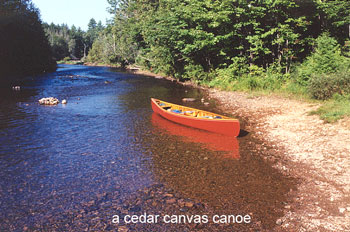FAQ
Q. What are the advantages of a wooden canoe?

The primary advantages of a wooden canoe are its appearance and its handling characteristics. Quite simply, no other material can match wood in these two respects. From an appearance perspective, the beauty of wood can't be matched by any other material. As for handling, a wooden canoe is quieter, warmer and more responsive to the water than any other material. The flexing of a wooden canoe, which is made of many pieces, allows it to respond to the water it floats in as well as the paddler it carries, as no moulded material can.
An additional feature of cedar canvas canoes, which is not shared by canoes of other materials, is that any part of the canoe can be repaired or replaced - no matter how old the canoe - thus restoring the canoe to an as-new condition.
Q. Does a wooden canoe require a lot of maintenance?
Being made of natural materials it is true that, on average, a wooden canoe will require more care than some other materials such as fibreglass, aluminum and plastic. To put it another way, wood will suffer more from neglect than these materials. However, the actual upkeep required by a wooden canoe depends on how it is used and stored and can be surprisingly low if a bit of common sense care is taken. For example, the paint and varnish on a wooden canoe, which represent the first line of defence for the wood, can provide many years of service before requiring attention if care is taken in the use and storage of the canoe.
Q. Can I use a wooden canoe for whitewater?
The short answer is yes. Until the advent of synthetic canoe materials, wooden canoes (specifically cedar canvas canoes) were used for all purposes including whitewater. However, today some other materials are more appropriate for this use in the sense that they are more impact resistant and suffer fewer consequences from striking a rock.
Q. How long does it take to build a cedar canvas canoe?
The length of time a builder spends to build a cedar canvas canoe will vary primarily with the emphasis placed on fit and finish details and can be anywhere between 80 and 200 hours.
Q. What do you do if you get a tear in the canvas?
A small tear in the canvas can be patched and, when repainted, rendered almost invisible. A tear which is too large to patch will require replacement of the canvas. However, the canvas on a canoe is really quite rugged and would require impact with a fairly sharp object to cause even a small tear.
Q. Why not use fibreglass instead of canvas on a canoe?
As previously mentioned, one of the advantages of a cedar canvas canoe is the ability to repair or replace any component. Because fibreglass is not readily removable, this advantage would be lost if it was used in place of canvas.
